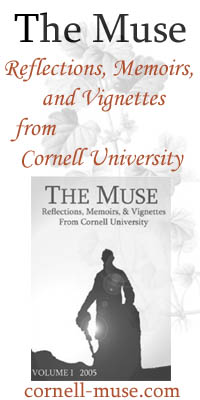Dan Jost '05 Asks 'Is This What A Caring Community Looks Like?'

Frequent readers of MetaEzra know that I've long vacillated on the issue of the gorge fences and have welcomed differing viewpoints on the topic. The following is a guest post by Dan Jost '05 based on research completed for his recent article in Landscape Architecture Magazine. Dan argues forcefully that there is no compelling evidence to support the building of bridge barriers on Cornell's campus. (All opinions expressed are of course that of Dan's alone.) Dan can be reached at djost.1983(at)gmail.com.
For months, Cornell has been arguing that the science backs their decision to install suicide barriers. For example, this is how Cornell’s Susan Murphy framed the debate to the Ithaca Times last summer:
“Most importantly, there is the scientific research on means restriction, which suggests that bridge barriers are an effective tool in suicide prevention,” she said. "Five or 10 years ago, there weren't any articles on this. Suicide prevention as a discipline is maturing."
Cornell’s insistence that the science is on their side has changed many minds. In the same article, Svante Myrick, Collegetown’s representative on the Ithaca Common Council, explained that he was originally skeptical about the fences. A majority of his constituents opposed them, he told the Times. But he voted to keep up the fences after he was presented with evidence by Cornell. "If you look at the studies, they really do show that bridge barriers work," he said. "It's about saving lives."
As a writer and editor at Landscape Architecture Magazine, I had the opportunity to explore this claim that suicide barriers would save lives for an article published in January. I imagine some people will stop reading right there. “This guy is only concerned about preserving pretty views,” they might assume. I will admit that the views are very important to me. Not only because they are pretty, but because I always found comfort in them. As a student at Cornell, staring into the gorges was my favorite way to clear my mind. When I was stressed or upset, walking by Triphammer Falls always lifted my spirits.
But I also understand the pain associated with losing someone to suicide in a gorge. A friend and co-worker—someone who I often shared jokes with—jumped into the Cascadilla Gorge during my sophomore year at Cornell. This, as much as anything, encouraged me on in my research. And what I found may surprise you. The evidence that barriers save lives is inconclusive at best, and in fact the best studies we have on the subject suggest they won’t save lives—that people will find other locations to jump or other means of committing suicide.
Researchers have clearly shown that suicide barriers can stop people from jumping in a certain location. Cornell’s report on suicide prevention strategies, compiled by Beautrais, Gould, and Caine last June, lists 5 case studies that attest to this.
However, none of these studies provides any evidence that barriers have saved lives. “No study of a suicide prevention barrier has shown a statistically significant drop in overall rates of suicide in the vicinity,” wrote Mark Sinyor and Anthony J. Levitt in the British Medical Journal this July, shortly after Cornell’s report came out.
This is not terribly surprising, since suicides from a single bridge rarely account for a very large percentage of suicides within a region. Many iconic sites have only a couple of suicides a year. But the construction of a barrier on Toronto’s Bloor Street Viaduct in 2003 provided an unusual opportunity for study, as this bridge had more suicides than any other bridge in North America, aside from the Golden Gate Bridge. If any site was an iconic site for suicide, attracting people who would have otherwise tried less deadly means, this was it, with an average of 9 suicides per year. Sinyor and Levitt’s study [LINK: http://www.bmj.com/content/341/bmj.c2884.full] found no drop in the jumping suicide rate in Toronto during the four years after the barrier went up, however, suggesting that people who would have jumped from the Bloor Street Viaduct migrated to other sites.
The Bloor Street Viaduct study was not the first study to show putting up a suicide barrier at an iconic site had no significant effect on jumping suicides overall, just the first to be clear about what it had found. A study by Thomas Reisch and Konrad Michel, which was published in Suicide and Life Threatening Behavior in 2005, showed no significant reduction in jumping suicides in Bern, Switzerland after a barrier went up on the city's iconic suicide bridge. That study can be read here. There were 45 jumping suicides per year in Bern in the 4 years before a barrier went up and 44 jumping suicides in Bern in the 4 years after the barrier went up. Had the barrier worked, one might have expected roughly 35.
Yet, Cornell’s report actually uses this study to argue that people won’t substitute sites. "After the installation of the net… the number of people jumping from all high places in Bern was significantly lower compared to the years before, indicating no immediate shift to other nearby jumping sites took place," reads the report (italics mine). Really?!! How do they come to that conclusion?
In the interest of fairness, it is easy to be confused by a cursory reading of Reisch and Michel’s report. One has to get the numbers I provide by reading a graph because the authors do not put them in a table or compare them directly in the text of the article. Rather than acknowledging that suicides were flat, the graph makes it look like the barrier actually prevented the suicide rate from rising.
For some reason, based on four years of data and how closely that data seems to fit a logarithmic curve, the authors make the bizarre assumption that the jumping suicide rate was increasing logarithmically and would have continued to rise if a barrier hadn't gone up, then note there is a significant difference between the number of suicides observed and this imaginary number. However, there is no reason to believe the jumping rate would have risen, based on another graph on page 465 of the report that shows how jumping suicides in Bern rose and fell between 1988 and 1998.
--
So, why haven’t these barriers had an impact on jumping suicides in their respective regions? I have a theory. Why would anyone who is trying to kill themselves go to a site where they know there’s a barrier, a place where they know suicide will be difficult, when other sites are available? “[P]eople tend to make their choice of method of suicide based upon their perceptions of what they understand to be certain to achieve death, to be quick, to be readily available, and to avoid risk of disfigurement,” noted Beautrais, Gould, & Caine in their report to Cornell. A site with a barrier no longer meets those criteria, but plenty of other sites will, especially in a place like Ithaca.
With barriers limited to Cornell’s bridges, it is easy to imagine students jumping from the nearby gorge edges. Local people who drove to Cornell to commit suicide could just as easily drive to other local sites, such as Taughannock Falls, as could the large number of students with cars.
At least one suicide has already occurred in Taughannock since the barriers went up at Cornell. Tine Rubow jumped to her death there shortly after graduating from Cornell in December. “This is a clear case of substitution of location from the fenced bridges,” argues IthacaisFences.org, which is calling for Cornell to remove the fences. A single death does not prove anything. But combined with our knowledge of the studies above, it should give pause to those who say the lack of suicides at Cornell in the past few months prove the fences will save lives.



